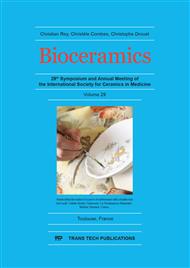[1]
H. Maeda, J. Wu, T. Sawa, Y. Matsumura, and K. Hori, Tumor vascular permeability and the EPR effect in macromolecular therapeutics: A review, J. Control. Release, 65 (2000) 271–284.
DOI: 10.1016/s0168-3659(99)00248-5
Google Scholar
[2]
F. Gao et al., Doxorubicin loaded silica nanorattles actively seek tumors with improved anti-tumor effects, Nanoscale, 4 (2012) 3365.
DOI: 10.1039/c2nr12094a
Google Scholar
[3]
D. Brevet et al., Mannose-targeted mesoporous silica nanoparticles for photodynamic therapy, Chem. Commun., 12 (2009)1475.
Google Scholar
[4]
J. L. Perry et al., PEGylated PRINT nanoparticles: The impact of PEG density on protein binding, macrophage association, biodistribution, and pharmacokinetics, Nano Lett., 12 (2006) 5304–5310.
DOI: 10.1021/nl302638g
Google Scholar
[5]
D. E. Owens and N. A. Peppas, Opsonization, biodistribution, and pharmacokinetics of polymeric nanoparticles, Int. J. Pharm., 307 (2006) 93–102.
DOI: 10.1016/j.ijpharm.2005.10.010
Google Scholar
[6]
M. Gary-Bobo et al., Multifunctionalized mesoporous silica nanoparticles for the in vitro treatment of retinoblastoma: Drug delivery, one and two-photon photodynamic therapy, Int. J. Pharm., 432 (2012) 99–104.
DOI: 10.1016/j.ijpharm.2012.04.056
Google Scholar
[7]
D. Kambhampati, T. Jakob, and J. Robertson, Novel silicon dioxide sol-gel films for potential sensor applications: a surface plasmon resonance study, Langmuir, 16 (2001) 1169–1175.
DOI: 10.1021/la001250w
Google Scholar
[8]
S. Szunerits, C.N. Kirchner, G. Wittstock, R. Boukherroub, C. Gondran, Electrochemical investigation of the influence of thin SiOx films deposited on gold on charge transfer characteristics, Electrochim. Acta, 53 (2008) 7908-7914.
DOI: 10.1016/j.electacta.2008.05.070
Google Scholar
[9]
E. Herth, R. Zeggari, J.Y. Rauch, F. Remy-Martin, W. Boireau, Investigation of amorphous SiOx layer on gold surface for surface plasmon resonance measurements, Microelectric Eng., 163 (2016) 43-48.
DOI: 10.1016/j.mee.2016.04.014
Google Scholar
[10]
I. Ruach-Nir, T.A. Bendikov, I. Doron-Mor, Z. Barkay, A. Vaskevich, I. Rubinstein, Silica-stabilized gold island films for transmission localized surface plasmon sensing, J. Am. Chem. Soc., 129 (2016) 84-92.
DOI: 10.1021/ja064919f
Google Scholar
[11]
W. R. Thompson, M. Cai, M. Ho, and J. E. Pemberton, Hydrolysis and Condensation of Self-Assembled Monolayers of (3-Mercaptopropyl)trimethoxysilane on Ag and Au Surfaces, Langmuir, 13 (1997) 2291–2302.
DOI: 10.1021/la960795g
Google Scholar
[12]
S. Besson, T. Gacoin, C. Jacquiod, C. Ricolleau, D. Babonneau, and J. -P. Boilot, Structural study of 3D-hexagonal mesoporous spin-coated sol–gel films, J. Mater. Chem., 10 (2000) 1331–1336.
DOI: 10.1039/a908845h
Google Scholar
[13]
N. Aissaoui, L. Bergaoui, J. Landoulsi, J. F. Lambert, and S. Boujday, Silane layers on silicon surfaces: mechanism of interaction, stability, and influence on protein adsorption, Langmuir, 28 (2012) 656–665.
DOI: 10.1021/la2036778
Google Scholar
[14]
M. J. Sweetman, C. J. Shearer, J. G. Shapter, and N. H. Voelcker, Dual silane surface functionalization for the selective attachment of human neuronal cells to porous silicon, Langmuir, 27 (2011) 9497–9503.
DOI: 10.1021/la201760w
Google Scholar


